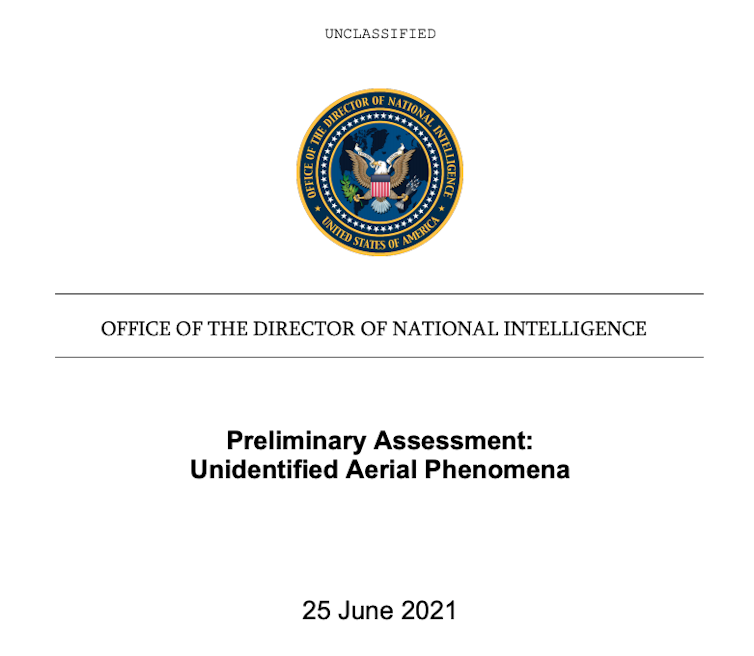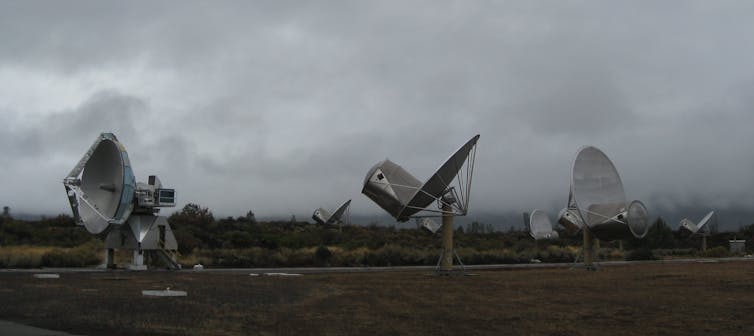No aliens, but government transparency and desire for better data might bring science to the UFO world
- Written by Chris Impey, University Distinguished Professor of Astronomy, University of Arizona
On June 25, 2021, the Pentagon released a much-anticipated report on UFOs to Congress[1]. The military has rebranded unidentified flying objects as unidentified aerial phenomena –UAPs – in part to avoid the stigma that has been attached to claims of aliens visiting the Earth since the Roswell incident in 1947[2]. The report presents no convincing evidence that alien spacecraft have been spotted, but some of the data defy easy interpretation.
I’m a professor of astronomy[3] who has written extensively on the search for life[4] in the universe. I also teach a free online class on astrobiology[5]. I do not believe that the new Pentagon report or any other sightings of UFOs in the past are proof of aliens visiting Earth. But the report is important because it opens the door for a serious look at UFOs. Specifically, it encourages the U.S. government to collect better data on UFOs, and I think the release of the report increases the chances that scientists will try to interpret that data. Historically, UFOs have felt off limits to mainstream science, but perhaps no more.
Three videos from the U.S. military sparked a recent surge in interest in UFOs.What’s in the UFO report?
The No. 1 thing the report focuses on is the lack of high-quality data. Here are the highlights from the slender nine-page report[6], covering a total of 144 UAP sightings from U.S. government sources between 2004 and 2021:
“Limited data and inconsistent reporting are key challenges to evaluating UAP.”
Some observations “could be the result of sensor errors, spoofing, or observer misperception.”
“UAP clearly pose a safety of flight issue and may pose a challenge to U.S. national security.”
Of the 144 sightings, the task force was “able to identify one reported UAP with high confidence. In that case, we identified the object as a large, deflating balloon. The others remain unexplained.”
“Some UAP many be technologies deployed by China, Russia, another nation, or non-governmental entity.”
 The Pentagon delivered the UFO report to Congress on June 25, 2021.
Office of the Director of National Intelligence[7]
The Pentagon delivered the UFO report to Congress on June 25, 2021.
Office of the Director of National Intelligence[7]
UFOs are taboo among scientists
UFO means unidentified flying object. Nothing more, nothing less. You’d think scientists would enjoy the challenge of solving this puzzle. Instead, UFOs have been taboo for academic scientists to investigate, and so unexplained reports have not received the scrutiny they deserve.
One reason is that most scientists think there is less to most reports than meets the eye[8], and the few who have dug deeply have mostly debunked the phenomenon[9]. Over half of sightings can be attributed[10] to meteors, fireballs and the planet Venus.
Another reason for the scientific hesitance is that UFOs have been co-opted by popular culture. They are part of a landscape of conspiracy theories that includes accounts of abduction by aliens[11] and crop circles[12]. Scientists worry about their professional reputations, and the association of UFOs with these supernatural stories causes most researchers to avoid the topic.
But some scientists have looked. In 1968, Edward U. Condon at the University of Colorado published the first major academic study of UFO sightings[13]. The Condon Report put a damper on further research when it found that “nothing has come from the study of UFOs in the past 21 years[14] that has added to scientific knowledge.”
However, a review in 1998[15] by a panel led by Peter Sturrock, a professor of applied physics at Stanford University, concluded that some sightings are accompanied by physical evidence that deserves scientific study. Sturrock also surveyed professional astronomers[16] and found that nearly half thought UFOs were worthy of scientific study, with higher interest among younger and more well-informed astronomers.
If astronomers are intrigued by UFOs – and believe some cases deserve study with academic rigor – what’s holding them back? A history of mistrust[17] between ufologists and scientists hasn’t helped. And while UFO research has employed some of the tools of the scientific method[18], it has not had the core of skeptical, evidence-based reasoning that demarcates science from pseudoscience[19].
A search of 90,000 recent and current grants awarded[20] by the National Science Foundation finds none addressing UFOs or related phenomena. I’ve served on review panels for 35 years, and can imagine the reaction if such a proposal came up for peer review: raised eyebrows and a quick vote not to fund.
 Radio telescopes like the Allen Telescope Array seen here scan the sky looking for signs of intelligent life in the universe.
Brewbooks/Wikimedia Commons, CC BY-SA[21][22]
Radio telescopes like the Allen Telescope Array seen here scan the sky looking for signs of intelligent life in the universe.
Brewbooks/Wikimedia Commons, CC BY-SA[21][22]
A decadeslong search for aliens
While the scientific community has almost entirely avoided engaging with UFOs, a much more mainstream search for intelligent aliens and their technology has been going on for decades.
The search is motivated by the fact that astronomers have, to date, discovered over 4,400 planets orbiting other stars[23]. Called exoplanets, some are close to the Earth’s mass and at just the right distance from their stars to potentially have water on their surfaces – meaning they might be habitable.
Astronomers estimate that there are 300 million habitable worlds[24] in the Milky Way galaxy alone, and each one is a potential opportunity[25] for life to develop and for intelligence and technology to emerge. Indeed, most astronomers think it very unlikely that humans are the only or the first advanced civilization[26].
This confidence has fueled an active search for extraterrestrial intelligence[27], known as SETI. It has been unsuccessful so far. As a result, researchers have recast the question “Are we alone?” to “Where are the aliens?” The absence of evidence for intelligent aliens is called the Fermi paradox[28]. First articulated by the physicist Enrico Fermi, it’s a paradox because advanced civilizations should be spread throughout the galaxy, yet we see no sign of their existence.
The SETI activity has not been immune from scientists’ criticism[29]. It was starved of federal funding for decades and recently has gotten most of its support from private sources[30]. However, in 2020, NASA resumed funding for SETI[31], and the new NASA administrator wants researchers to pursue the topic of UFOs[32].
In this context, the Pentagon report is welcome. The report draws few concrete conclusions[33] about UFOs and avoids any reference to aliens or extraterrestrial spacecraft. However, it notes the importance of destigmatizing UFOs so that more pilots report what they see. It also sets a goal of moving from anecdotal observations to standardized and scientific data collection. Time will tell if this is enough to draw scientists into the effort, but the transparency to publish the report at all reverses a long history of secrecy surrounding U.S. government reports on UFOs[34].
I don’t see any convincing evidence of alien spacecraft, but as a curious scientist, I hope the subset of UFO sightings that are truly unexplained gets closer study. Scientists are unlikely to weigh in if their skepticism generates attacks from “true believers” or they get ostracized by their colleagues. Meanwhile, the truth is still out there.
[Understand new developments in science, health and technology, each week. Subscribe to The Conversation’s science newsletter[35].]
References
- ^ report on UFOs to Congress (www.dni.gov)
- ^ Roswell incident in 1947 (www.livescience.com)
- ^ professor of astronomy (www.as.arizona.edu)
- ^ search for life (www.cambridge.org)
- ^ free online class on astrobiology (www.coursera.org)
- ^ slender nine-page report (www.dni.gov)
- ^ Office of the Director of National Intelligence (www.dni.gov)
- ^ less to most reports than meets the eye (www.fraknoi.com)
- ^ debunked the phenomenon (doi.org)
- ^ Over half of sightings can be attributed (www.ianridpath.com)
- ^ abduction by aliens (doi.org)
- ^ crop circles (www.smithsonianmag.com)
- ^ first major academic study of UFO sightings (files.ncas.org)
- ^ nothing has come from the study of UFOs in the past 21 years (www.jstor.org)
- ^ review in 1998 (news.stanford.edu)
- ^ surveyed professional astronomers (www.scientificexploration.org)
- ^ history of mistrust (doi.org)
- ^ some of the tools of the scientific method (doi.org)
- ^ pseudoscience (www.scientificamerican.com)
- ^ grants awarded (www.nsf.gov)
- ^ Brewbooks/Wikimedia Commons (commons.wikimedia.org)
- ^ CC BY-SA (creativecommons.org)
- ^ over 4,400 planets orbiting other stars (exoplanetarchive.ipac.caltech.edu)
- ^ 300 million habitable worlds (www.cnn.com)
- ^ potential opportunity (www.seti.org)
- ^ humans are the only or the first advanced civilization (exoplanets.nasa.gov)
- ^ search for extraterrestrial intelligence (www.seti.org)
- ^ Fermi paradox (www.seti.org)
- ^ criticism (doi.org)
- ^ private sources (www.sciencemag.org)
- ^ resumed funding for SETI (www.usatoday.com)
- ^ pursue the topic of UFOs (www.cnn.com)
- ^ few concrete conclusions (apnews.com)
- ^ secrecy surrounding U.S. government reports on UFOs (www.nytimes.com)
- ^ Subscribe to The Conversation’s science newsletter (theconversation.com)

















